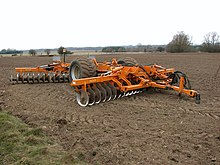
Back كاربة Arabic Лушчыльнік Byelorussian Arada de discs Catalan Egge (Landtechnik)#Scheibenegge oder Telleregge German Arado de discos Spanish Randaal Estonian Lautasäes Finnish Déchaumeuse French Чинијарка Macedonian Schijveneg Dutch
This article needs additional citations for verification. (March 2009) |


A disc harrow is a harrow whose cutting edges are a row of concave metal discs, which may be scalloped or set at an oblique angle. It is an agricultural implement that is used to till the soil where crops are to be planted. It is used to chop up unwanted weeds or crop residue. It is also one of the many soil cultivation implements alongside tilers and moldboard ploughs.
It consists of many carbon steel discs, and sometimes longer-lasting boron steel discs, which have many varying concavities and disc blade sizes and spacing (the choices of the latter being determined by the final result required in a given soil type) and which are arranged into two sections ("offset disc harrow") or four sections ("tandem disc harrow"). When viewed from above, the four sections would appear to form an "X" which has been flattened to be wider than it is tall. The discs are also offset so that they are not parallel with the overall direction of the implement. This arrangement ensures that the discs will repeatedly slice any ground to which they are applied, to optimize the result. The concavity of the discs as well as their offset angle causes them to loosen and lift the soil that they cut.
A discer is an evolved form of a disc harrow, more suitable to Saskatchewan prairies, where it was developed in the 1940s. It does not leave ridging and it is lighter to pull, so it can be made bigger. After the 1980s their domination started to fade.[1]
- ^ A New Machine, Ruth Bitner, Western Development Museum, Canada, October 2012.
© MMXXIII Rich X Search. We shall prevail. All rights reserved. Rich X Search